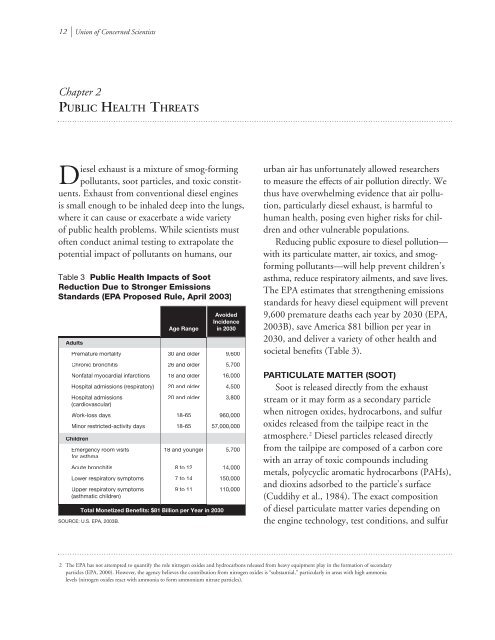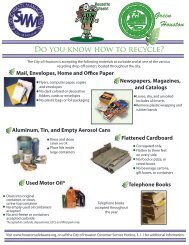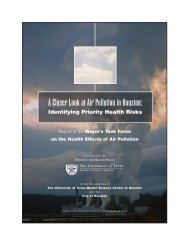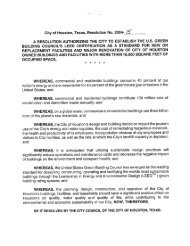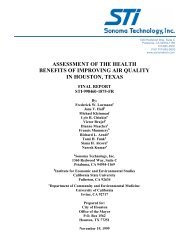Cleaning Up Diesel Pollution - Union of Concerned Scientists
Cleaning Up Diesel Pollution - Union of Concerned Scientists
Cleaning Up Diesel Pollution - Union of Concerned Scientists
- No tags were found...
Create successful ePaper yourself
Turn your PDF publications into a flip-book with our unique Google optimized e-Paper software.
12 l<strong>Union</strong> <strong>of</strong> <strong>Concerned</strong> <strong>Scientists</strong>Chapter 2PUBLIC HEALTH THREATS<strong>Diesel</strong> exhaust is a mixture <strong>of</strong> smog-formingpollutants, soot particles, and toxic constituents.Exhaust from conventional diesel enginesis small enough to be inhaled deep into the lungs,where it can cause or exacerbate a wide variety<strong>of</strong> public health problems. While scientists must<strong>of</strong>ten conduct animal testing to extrapolate thepotential impact <strong>of</strong> pollutants on humans, ourTable 3 Public Health Impacts <strong>of</strong> SootReduction Due to Stronger EmissionsStandards (EPA Proposed Rule, April 2003)AdultsAge RangeAvoidedIncidencein 2030Premature mortality 30 and older 9,600Chronic bronchitis 26 and older 5,700Nonfatal myocardial infarctions 18 and older 16,000Hospital admissions (respiratory) 20 and older 4,500Hospital admissions(cardiovascular)20 and older 3,800Work-loss days 18-65 960,000Minor restricted-activity days 18-65 57,000,000ChildrenEmergency room visitsfor asthma18 and younger 5,700Acute bronchitis 8 to 12 14,000Lower respiratory symptoms 7 to 14 150,000<strong>Up</strong>per respiratory symptoms(asthmatic children)9 to 11 110,000Total Monetized Benefits: $81 Billion per Year in 2030SOURCE: U.S. EPA, 2003B.urban air has unfortunately allowed researchersto measure the effects <strong>of</strong> air pollution directly. Wethus have overwhelming evidence that air pollution,particularly diesel exhaust, is harmful tohuman health, posing even higher risks for childrenand other vulnerable populations.Reducing public exposure to diesel pollution—with its particulate matter, air toxics, and smogformingpollutants—will help prevent children’sasthma, reduce respiratory ailments, and save lives.The EPA estimates that strengthening emissionsstandards for heavy diesel equipment will prevent9,600 premature deaths each year by 2030 (EPA,2003B), save America $81 billion per year in2030, and deliver a variety <strong>of</strong> other health andsocietal benefits (Table 3).PARTICULATE MATTER (SOOT)Soot is released directly from the exhauststream or it may form as a secondary particlewhen nitrogen oxides, hydrocarbons, and sulfuroxides released from the tailpipe react in theatmosphere. 2 <strong>Diesel</strong> particles released directlyfrom the tailpipe are composed <strong>of</strong> a carbon corewith an array <strong>of</strong> toxic compounds includingmetals, polycyclic aromatic hydrocarbons (PAHs),and dioxins adsorbed to the particle’s surface(Cuddihy et al., 1984). The exact composition<strong>of</strong> diesel particulate matter varies depending onthe engine technology, test conditions, and sulfur2 The EPA has not attempted to quantify the role nitrogen oxides and hydrocarbons released from heavy equipment play in the formation <strong>of</strong> secondaryparticles (EPA, 2000). However, the agency believes the contribution from nitrogen oxides is “substantial,” particularly in areas with high ammonialevels (nitrogen oxides react with ammonia to form ammonium nitrate particles).


